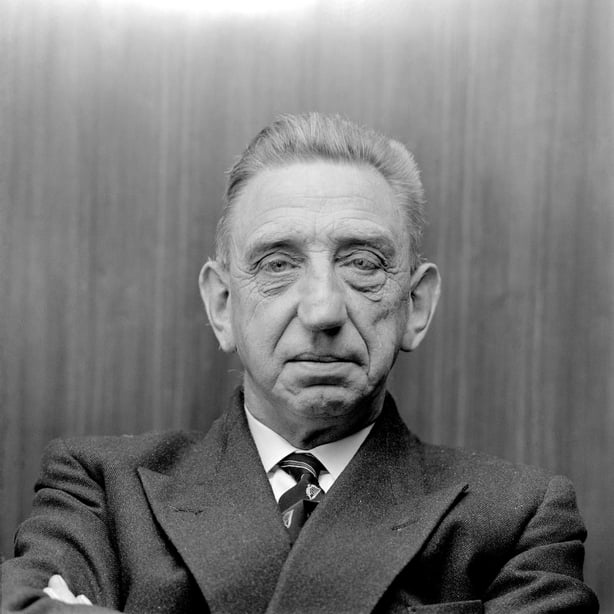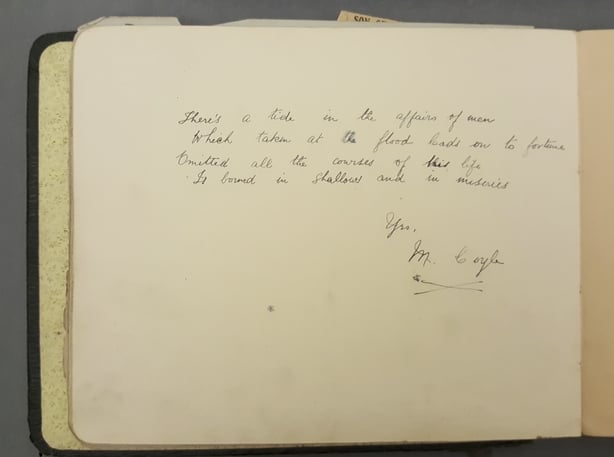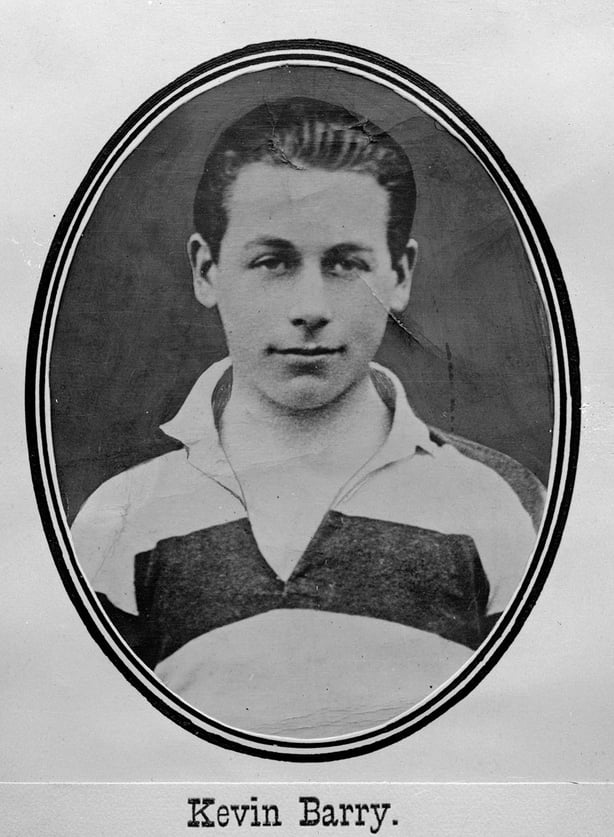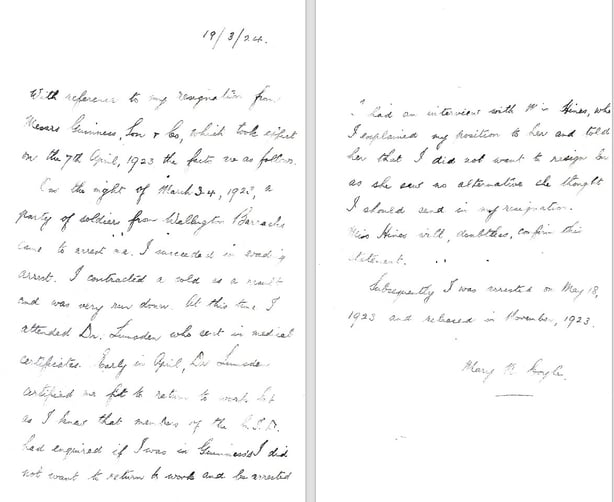In the first in a new series, Family Histories, Sinéad Andrews tells the story of her extraordinary grandmother Mary Coyle, whose adventures and achievements have been overshadowed by those of her better known husband.
Remarkable people make exceptional contributions to the world around us. Our lives are often better because of them. But what if history breezed over their contributions? What if books recounted a revolution while leaving groups of remarkable people out? Is it possible to stitch together the frayed threads of personal sacrifices that would have been forever consigned to the archives?
Mary Coyle was a remarkable woman. She was active in the War of Independence and the Irish Civil War. Although yet to meet him, on the other side of Dublin town, her future husband was also intensely active. They were both imprisoned, and both went on several hunger strikes.
Her husband's name was Todd Andrews and he wrote two fascinating books about this period. Mary is mentioned on occasion, but in comparison to what my fastidious research has unearthed, it falls embarrassingly short.

I have been investigating her life over the past few years with an almost forensic obsession. What I've also found remarkable is not only how much of her information I've discovered in the archives, but how little was known of her revolutionary life up to now. In the Dictionary of Irish Biography describing Todd Andrews, the only reference to Mary Coyle is "He married first (1928) Mary Coyle of Dublin (d. 1967)". It reads like a sentence that would rather be out drinking whiskey and smoking cigars.
And when we think of Ireland's founding document, the Proclamation of the Irish Republic, proclaiming freedom from Britain, we think of its impassioned words of equal rights for every Irishman and every Irishwoman. These words were first read in public that fateful day at the GPO on Easter Monday, 1916 by Padraig Pearse to describe the Republic of Ireland they were prepared to die for. Ten days later he was executed. The ambitions for gender equality didn’t last much longer.
Not too far from the GPO that same day a 16-year-old girl, Mary Noel Coyle, was in her final year of school in Loreto Convent, 53 St. Stephens Green. Luckily for her and her classmate Elgin Barry they were on Easter break and relatively safe in their homes on Mespil Road and Fleet St. Less fortunate however was one of the Loreto nuns, who barely escaped the firing bullets inside her bedroom from the battle at St. Stephens Green. A priest reporting the incident writes, "she was awakened by the crash of a bullet through her windowpane. It struck the wall opposite and fell on her bed". Mary’s brother Donny was later to recall walking down Sackville St. (now O’Connell St.) with their father, seeing the Volunteers piling the post bags on the windows of the GPO. The subsequent school term (as with so much else) was disrupted for some weeks leaving Mary and Elgin some time to reflect on the latest events.

I discovered a message Mary wrote to one of her classmates during this time. She quotes Brutus to Cassius in The Tragedy of Julius Caesar, "There’s a tide in the affairs of men, Which taken at the flood leads to fortune…" Brutus advises to make the most of circumstances while in their favour. Somewhat portentous given Rome descends into Civil War!
Two years earlier, in 1914, the Coyle’s, of which Mary was the eldest of nine children, had only recently arrived in Dublin. They had moved from Derry, at a time when the IRB and the UVF were forming in opposition to each other over Home Rule in Ireland. Her father, tea merchant John Coyle, was a Catholic city councillor for the Nationalist Party. His departure from Derry was likely informed by a sense of panic that they would end up in a new northern state under British rule. A significant increase in violence was building including around Bridge Street, where the 'Coyle & Co’ tea shop operated. 1914 must have felt like the right time to move south.

Mary’s mother, Katie Begley, also from a tea merchant family in Limerick, was one of the first women to attend the Royal University in Dublin and a self-described feminist who wasn’t short of her own political leanings, admiring the likes of James Larkin and Hanna Sheehy-Skeffington. Her father, David Begley was in the Irish Parliamentary Party and the Town Commissioner of Limerick City. Katie was also to play her own part in the War of Independence by providing their home on Mespil Road as a safe house. This piece of family lore is backed up by a note from Michael Collins to his secretary Patricia Hoey.
Revolutionary spirit
Mary’s revolutionary spirit, matched with this DNA doused in political markers, was ignited when a family friend was executed by the British in 1920. I found a speech Mary gave in the 1960’s pinpointing the moment her fight for Ireland's freedom became deeply personal. Everything changed when her school friend Elgin’s brother Kevin, aged 18 was executed by hanging in November 1920.

By then, aged 20, Mary had become close to all the Barry family. She recalls joining Cumann na mBan straight away and indeed, the records show her joining their Ranelagh Branch ten days later. And it was Elgin she was to find herself in jail on hunger strike with in 1923. Letters from Mary to Elgin found in Elgin’s Papers reveal a young girl traumatized, having been tricked into breaking hunger strike by the prison warden, forcing her to leave her dear, brave Elgin to continue for another two weeks. During the Civil War, which Mary called a ‘regrettable necessity’, 645 women were interned, 219 women went on numerous hunger strikes, two of which were Mary and Elgin.
Undercover operative
Mary’s first job in Dublin was at the British Ministry for Labour. We also know at the same time she was reporting to Richard Mulcahy, IRA Chief of Staff as his dispatch carrier. Women were such unlikely agents of war that the British didn’t initially consider them in their surveillance efforts. This proved to be an enormous asset to the Irish allowing them go relatively unnoticed to pass orders, plans and intelligence across the battlefields of Ireland.
My father donated a brown leather satchel to historian Sinéad McCoole that had been gifted to Mary from Countess Markievicz. An interesting connection, given the Countess was in the underground Irish government as their appointed Minister of Labour. One could speculate that Mary might have been passing information from the British Ministry of Labour to the Irish Department of Labour.

HR files discovered during her time working in Guinness from August 1920 to May 1923 reveal fascinating details of her double life working as office clerk by day and dispatch carrier by night. It was emotional to read in her own writing to explain why she was sick, "On the night of 3rd March 1923, a party of soldiers from Wellington Barracks came to arrest me, but I succeeded in evading arrest’. The family story is that she was hiding guns on the top of the wardrobe and had to jump out the bathroom window and stay out all night to avoid further arrest.
A life of astonishing stories
The stories continue and are endless. WB Yeats was driven to call her ‘despicable’ during a protest in the Abbey Theatre. In the 1950’s, I found her on a ballot sheet successfully elected Chairwoman of the Irish Housewives Association. Poor branding of what was essentially a lobby group using wrath rather than dollar to have government protect families from poverty. Her friend Jeanne Heon-Canonne writes to see if Marys’ kids would like to do a French exchange with hers. Further examination reveals that Jeanne was in the French Resistance, imprisoned and tortured by the German Police!
Mary Noel Andrews (née Coyle), my grandmother, died in October 1967. We never met, but thanks to some tenacious needlework stitching her story together, I would like to set the record straight: she was indeed a remarkable woman.
Do you have a story to tell about your own family's experience of significant historical events? Find out how to contribute it here.
The views expressed here are those of the author and do not represent or reflect the views of RTÉ










































